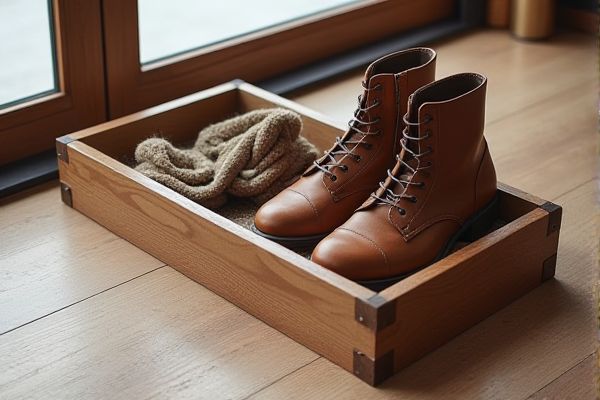
Shoe trays are typically smaller and designed to hold everyday shoes, keeping your entryway organized and free from dirt and moisture, while boot trays are larger, deeper, and specifically tailored to accommodate bulky, often wet boots, offering better protection for your floors. Discover which tray suits your footwear needs best by reading the rest of the article.
Table of Comparison
| Feature | Shoe Tray | Boot Tray |
|---|---|---|
| Purpose | Holds and organizes shoes | Specifically designed for boots |
| Size | Compact, fits standard shoes | Larger, accommodates taller boots |
| Depth | Shallow depth | Deeper base for boot shafts |
| Material | Plastic, rubber, or wood | Durable rubber or heavy-duty plastic |
| Water Resistance | Moderate water resistance | High water and dirt containment |
| Common Uses | Entryways, closets for daily shoes | Mudrooms, garages for wet or dirty boots |
| Price Range | Typically lower cost | Usually higher cost due to size and durability |
Introduction to Shoe Trays and Boot Trays
Shoe trays and boot trays provide practical solutions for organizing and protecting floors from dirt, mud, and moisture brought in by footwear. A shoe tray is typically smaller and designed to hold everyday shoes, while a boot tray features a larger, deeper design to accommodate bulkier boots and contain more debris. Both trays are made from materials like plastic, rubber, or silicone to ensure durability and easy cleaning.
Purpose and Functionality Differences
Shoe trays are designed specifically to hold smaller footwear such as sneakers and dress shoes, keeping them organized and preventing dirt from spreading indoors. Boot trays offer extra depth and space to accommodate larger, bulkier boots and are often made with raised edges to contain mud, water, and snow more effectively. Your choice depends on the type of footwear you need to manage and the level of protection required for your floors.
Material Comparison: Shoe Trays vs Boot Trays
Shoe trays are typically made from lightweight plastic or rubber materials designed to hold smaller footwear and absorb moisture, making them easy to clean and move. Boot trays are often constructed from heavier-duty materials such as thick rubber or reinforced plastic to accommodate larger, bulkier boots and prevent water and mud from damaging floors. Both trays prioritize durability and water resistance, but boot trays generally feature deeper wells and stronger materials for added protection in harsher conditions.
Size and Capacity Considerations
Shoe trays are typically smaller and designed to hold multiple pairs of shoes in compact spaces, making them ideal for everyday footwear organization. Boot trays usually have larger dimensions and deeper lips to accommodate taller and bulkier boots, preventing dirt and moisture from spreading. Choosing the right size and capacity ensures your shoe or boot tray effectively contains messes while fitting your available space.
Design Features: Raised Edges, Patterns, and Drainage
Shoe trays often feature low-profile raised edges designed to contain dirt and moisture without being obtrusive, making them ideal for smaller footwear and indoor use. Boot trays typically have higher raised edges and deeper basins with textured patterns to better manage larger amounts of water, mud, and snow from boots. Both trays incorporate drainage grooves or channels to prevent water pooling and promote faster drying, but boot trays emphasize sturdier construction and non-slip surfaces for heavy-duty use.
Best Uses for Shoe Trays
Shoe trays are ideal for organizing and protecting entryways from dirt, mud, and moisture brought in by everyday footwear such as sneakers, flats, and dress shoes. They work well in small spaces like closets or mudrooms where you need to keep shoes neatly contained and prevent floor damage. Your shoe tray can also serve as a convenient spot to air out shoes and keep your home cleaner and more organized.
Best Uses for Boot Trays
Boot trays are designed with taller sides and larger dimensions to effectively contain mud, water, and debris from heavy-duty footwear such as winter boots and rain boots. Their best uses include entryways, mudrooms, and garages where they protect flooring from wet and dirty boots during inclement weather. Boot trays also provide organized storage, preventing clutter and maintaining cleanliness in high-traffic areas.
Cleaning and Maintenance
Shoe trays are designed with smaller compartments and grooved surfaces to capture dirt and moisture from everyday footwear, making cleaning straightforward by simply wiping or rinsing. Boot trays, being larger and deeper, accommodate bulky boots and hold more mud or water, requiring occasional scrubbing and thorough drying to prevent odors and mold buildup. Choosing the right tray for your needs ensures your entryway stays cleaner with minimal maintenance effort.
Price Differences and Value
Shoe trays generally cost less, ranging from $10 to $30, while boot trays are priced higher, typically between $25 and $60 due to their larger size and durable materials designed to handle heavy boots. The value of a boot tray comes from its ability to contain mud, water, and debris more effectively for outdoor and winter footwear, whereas shoe trays provide a compact solution ideal for everyday sneakers and indoor shoes. Investing in a boot tray offers long-term protection for flooring in harsher environments, justifying the higher price compared to the lighter-duty shoe trays.
Choosing the Right Tray for Your Needs
Selecting the right tray depends on the type of footwear and the available space; shoe trays are typically smaller and designed for daily shoes, while boot trays are larger and accommodate bulkier boots. Consider the material and waterproof features to protect floors from mud, snow, or water when storing outdoor footwear. Measure your entryway or closet space to ensure the tray fits comfortably without causing clutter.
 homyna.com
homyna.com